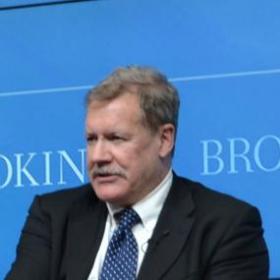
Austin Says Putin's Eurasian Union will Test Brussels
Writing for New Europe, EWI's Professorial Fellow Greg Austin argues that the creation of the Eurasian Union—a union between Russia, Belarus and Kazakhstan—will test relations with the EU.
Read the full piece here on New Europe.
If ever the European Union needed a different eastern policy, it will certainly be the case on 1 January 2015, once the Eurasian Union (EaU) – my abbreviation – takes concrete existence.
The treaty which will give life to the new union is due to be signed by Russia, Belarus and Kazakhstan on 29 May 2014. In August 2013, the Yanukovych government in Ukraine expressed interest in being an observer to the new organization. The EaU, to be dominated by Russian officials, is as much a geopolitical gambit as an economic one.
The former U.S. Secretary of State, Hillary Clinton, is reported to have said in 2012 about the EaU that the United States was “trying to figure out effective ways to slow down or prevent it”. Her reason was that it was a Russian attempt to reassert influence in the post-Soviet space. State Department officials have been ignoring it in their public remarks. Most Western analysts have regarded it as something of a joke.
Well, Vladimir Putin is deadly serious about this project, so it would profit all of us to study it and develop policy for it.
On the Russian side, the EaU plan has been fifteen years in the making, with the establishment by treaty in 2000 of the Eurasian Economic Community, joined by Belarus, Kazakhstan, the Kyrgyz Republic, Russia and Tajikistan. Ukraine and Moldova became observers in 2002. Though the idea originally came from Kazakhstan’s President Nazarbayev 20 years ago, the treaty setting it up was signed just seven months after Putin’s acting presidency of Russia was made whole in the March 2000 election.
The essence of the future problems between the EaU and the EU lies not so much in their independent operation, but in what is increasingly taking the form of a contested zone between them – the territory of Ukraine and Moldova. We can get a taste of what lies ahead from a speech prepared by the Commissioner for Enlargement, Štefan Füle, in the lead up to the now historic Vilnius Summit on the EU’s Eastern Partnership, the occasion when Ukraine walked away from its commitment to sign the Association agreement.
The Füle document of 11 September 2013 was surprisingly confrontational, especially in its title, even though he was claiming to be more moderate than most: “Statement on the pressure exercised by Russia on countries of the Eastern Partnership”. It warned: “The last thing we want to see is a protectionist wall cutting our continent in two. … we cannot afford to waste our efforts on a regional geopolitical rivalry.” He laid some misplaced blame at the feet of Russia for sequencing. He said that “When we set out to build the Eastern Partnership at Prague in 2009, the Eurasian Union project had yet to get off the ground. It is the Russian decision to build the Customs Union and the Eurasian Union that created a situation where our European partners are now confronted with a choice”.
The choice made by Ukraine at the Vilnius summit could have been foreseen because of the Russian pressure so well characterized by Füle. Immediately after the event, Spiegel Online warned in a headline on 29 November 2013 “EU Needs New Russia Policy after Ukraine Debacle”. The EU did not adjust its policy. In twenty years of the Common Foreign and Security Policy, the EU has never been able to agree on a viable common strategy toward Russia. After the historic ten-state expansion of the EU in 2004, and with the EU’s Eastern policy cemented less than one year after the Georgia crisis in 2008, there may have never been any real hope of a workable relationship with Russia. The Füle prediction of inter-bloc economic tension now seems inevitable.

